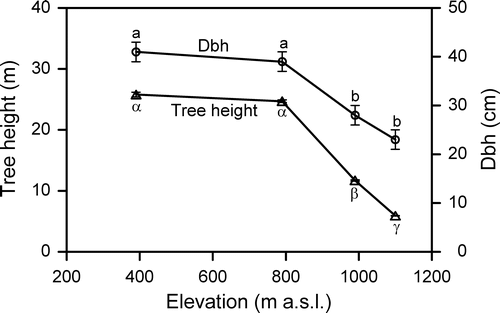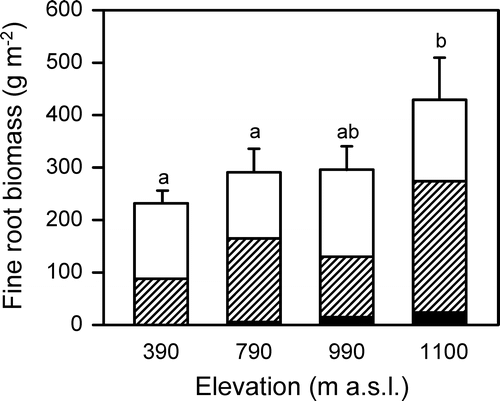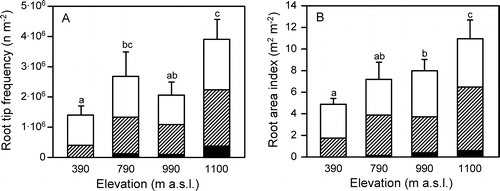Figures & data
TABLE 1 Morphological and chemical soil properties of four spruce stands along the elevational transect at Mount Brocken. Thickness of the organic layer and the mineral soil was recorded at 20 sampling locations per plot. The pH values, cation exchange capacity (CEC), base saturation, and C∶N ratio were measured from five mineral soil samples per plot and refer to A horizons.
TABLE 2 Micro-climatic conditions inside the four spruce stands along the elevational transect at Mount Brocken. For more detailed information on the methodology of climate measurements see methods description chapter section. Soil moisture contents are mean values ±1 SE; n = 5.
FIGURE 1 Tree height and stem diameter at breast height of four spruce stands along the elevational transect at Mount Brocken. Given are means ±1 SE. Different Latin or Greek letters indicate significant differences between the stands (P < 0.05).

TABLE 3 Above-ground structural characteristics of four spruce stands along the elevational transect at Mount Brocken.
FIGURE 2 Fine root biomass of four spruce stands along the elevational transect at Mount Brocken. Given are means ±1 SE. Open bars: organic layer; hatched bars: 0–10 cm mineral soil; black bars: 10–20 cm mineral soil. Different letters indicate significant differences in the profile totals between the stands (P < 0.05).

TABLE 4 Density of living fine root mass, live∶dead ratio of fine root mass, and fine root morphological traits in the organic layer and the upper mineral soil in four spruce stands along the elevational transect. Given are means ±1 SE; n = 20. Different letters indicate significant differences between the forest stands (P < 0.05).
FIGURE 3 Root tip frequency (A) and root area index (B) of four spruce stands along the elevational transect at Mount Brocken. Given are means ±1 SE. Open bars: organic layer; hatched bars: 0–10 cm mineral soil; black bars: 10–20 cm mineral soil. Different letters indicate significant differences in the profile totals between the stands (P < 0.05).

TABLE 5 Annual fine root production, mortality, turnover, and the ratio of fine root production to stem biomass in the lowermost, mid-elevation, and uppermost spruce stands of the elevational transect at Mount Brocken. Given are values of the total soil profile.